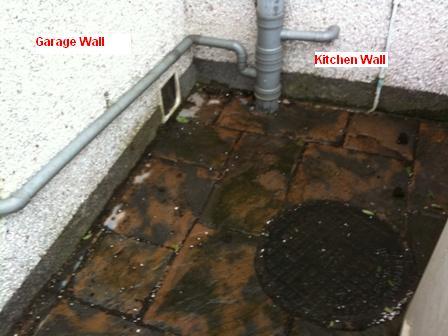I have now edited/shortened this port as it was VERY long.
The garage that is attached to our house has damp patches where the wall meets the floor at various points along two walls (only after it has been raining).
The 2 x problematic walls are:
1. The wall opposite the double garage doors (basically the rear wall of the garage) which has paving/patio slabs on the outside that are built up against the garage wall - with no visible drainage in place.
Paving is rather uneven and water that lands on the first two rows actually runs towards the garage wall (I would assume that the concrete base/bed has sunk or dropped over time).
2. The wall opposite the main house which has (on the outside) an approximately 18" wide cement slab with a runoff channel in the centre that runs towards the front of the garage where there is a drain (due to an inconsistent pitch, water does not run effectively).
Between the edge of this slab and the neighbouring fence, is about a 6" drop to what must be the ground level.
Here are two pictures showing the outside of each problem area - you can see a small amount of water pooled in the channel down the side slab in the one photo.
On the inside, all of the way around the base of the garage, there is a single course of bricks, above which is the DPC and then garage block walls.
The damp patches are all coming from that first course of bricks BELOW the DPC.
The top/surface of the slabs/pavers on the outside are an inch or so above the DPC --- I realise this is vague, but I do not know how to do an accurate measurement --- bottomline is that water lying on these these slabs/pavers are definitely higher than that first brick course, but not by a huge amount.
Here is a picture of a damp patch on the inside.
What I would like to do (reason explained in one of my posts to follow) is as follows:
At the back where the patio/pavers are - lift the first two rows, or perhaps all of the paving and re-lay them so that the water runs away from the house and garage walls.
On the side of the garage - get the water to run AWAY from the wall and then also ensure that whatever channel is in place runs properly towards the drain.
In both cases, I would also consider covering each area with a fixed awning type of affair with proper guttering in place, so that 99% of any rain is kept away from the slabs and walls in the first place.
Thanks in advance for any thoughts and advice.
Steve
The garage that is attached to our house has damp patches where the wall meets the floor at various points along two walls (only after it has been raining).
The 2 x problematic walls are:
1. The wall opposite the double garage doors (basically the rear wall of the garage) which has paving/patio slabs on the outside that are built up against the garage wall - with no visible drainage in place.
Paving is rather uneven and water that lands on the first two rows actually runs towards the garage wall (I would assume that the concrete base/bed has sunk or dropped over time).
2. The wall opposite the main house which has (on the outside) an approximately 18" wide cement slab with a runoff channel in the centre that runs towards the front of the garage where there is a drain (due to an inconsistent pitch, water does not run effectively).
Between the edge of this slab and the neighbouring fence, is about a 6" drop to what must be the ground level.
Here are two pictures showing the outside of each problem area - you can see a small amount of water pooled in the channel down the side slab in the one photo.
On the inside, all of the way around the base of the garage, there is a single course of bricks, above which is the DPC and then garage block walls.
The damp patches are all coming from that first course of bricks BELOW the DPC.
The top/surface of the slabs/pavers on the outside are an inch or so above the DPC --- I realise this is vague, but I do not know how to do an accurate measurement --- bottomline is that water lying on these these slabs/pavers are definitely higher than that first brick course, but not by a huge amount.
Here is a picture of a damp patch on the inside.
What I would like to do (reason explained in one of my posts to follow) is as follows:
At the back where the patio/pavers are - lift the first two rows, or perhaps all of the paving and re-lay them so that the water runs away from the house and garage walls.
On the side of the garage - get the water to run AWAY from the wall and then also ensure that whatever channel is in place runs properly towards the drain.
In both cases, I would also consider covering each area with a fixed awning type of affair with proper guttering in place, so that 99% of any rain is kept away from the slabs and walls in the first place.
Thanks in advance for any thoughts and advice.
Steve




